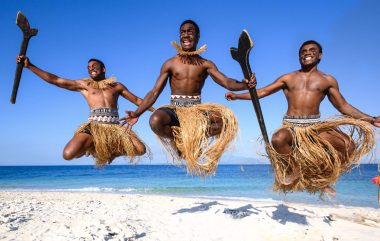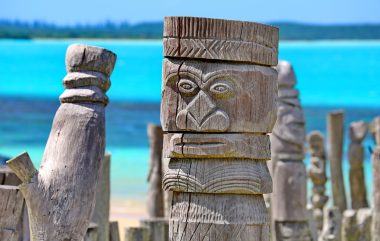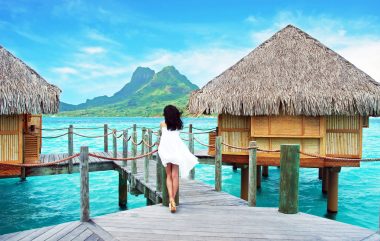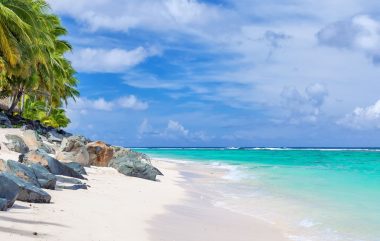
Luxury Travel to the Fijian Archipelago: A Perfect Pairing with New Zealand
Why Combine Your New Zealand Holiday with Fiji? Picture this: the rugged landscapes of N...
Read more
FRANKLY, NEW CALEDONIA is a bit greedy. It isn’t enough that the South Pacific archipelago has all the trappings of a desirable tropical destination – island hopping, fruits that radiate sunshine when you bite into them, watersports and an abundance of sun loungers. Being an overseas French territory means it’s also imbued with a certain Gallic flair, especially in the food. New Caledonia also has one of the largest lagoons in the world, and six areas of reef, lagoon and other ecosystems are registered as a UNESCO World Heritage site.

It isn’t clear how long Melanesian people were living on the country’s islands (estimates range from 3500 to 5000 years) before Catholic and Protestant missionaries came along in the early 1840s, but France didn’t waste much time after that and claimed New Caledonia in 1853. Since then, people from many cultures have made their home here, particularly from Indonesia, Vietnam, China and Japan, as well as other French-colonised islands. New Caledonia might just be the South Pacific’s ultimate melting pot, and it’s only a three-hour flight from New Zealand, and Australia. Noumea, near the southern end of Grande Terre (the main island), is a great place to begin exploring.
On the French Riviera, Nice’s Promenade des Anglais is the place to, well, promenade and people-watch – and the pretty bay of Anse Vata is touted as Noumea’s equivalent.

Shops, restaurants, bars and hotels ensure it’s a busy place day and night, and water-lovers can hire stand-up paddleboards, kayaks and windsurfers. Nearby Baie des Citrons is more sheltered from the prevailing wind, and better for swimming and sunbathing. Palm trees line the promenade as it links the two bays, and continues to trace the peninsula’s outline. This 10km stretch around Noumea’s waterfront is a magnet for walkers, runners and cyclists.
Spot echoes of the country’s history in the suburb of Faubourg Blanchot, where some colonial-style houses still stand. Built for comfort in the tropical heat, with wide verandahs and metal roofs, some homes also sport pops of colour that rival the plants in their gardens. A walking trail in French and English can be downloaded from noumea.nc (search “Les parcours historiques et culturels”). The streets around Place des Cocotiers (Coconut Plaza), another people-watching destination, are the place to start if you’re looking for French fashion, from boutiques to high-street retailers. Suburban malls, and the promenade along Anse Vata, are also good places to investigate.
Petroglyphs carved into mountainsides a few thousand years ago long pre-date Captain James Cook’s arrival in 1774. Apparently he named it thus because Grande Terre’s mountains reminded him of the Scottish highlands – though presumably he was remembering a very, very good weather day for Scotland.
Today, approximately 40 percent of New Caledonia’s population identifies as Kanak, and some still live in tribal villages.

Homestays and cultural experiences are available in the Loyalty Islands, or in the north or east of Grande Terre. But for a comprehensive introduction to the indigenous Melanesian culture’s stories,Homestays and cultural experiences are available in the Loyalty Islands, or in the north or east of Grande Terre. But for a comprehensive introduction to the indigenous Melanesian culture’s stories, art and world view, head to outer Noumea for the Tibaou Cultural Centre – named after Jean-Marie Tjibaou, leader of the Kanak independence movement.
The centre was designed by Italian architect Renzo Piano, also responsible for the Pompidou Centre in Paris and London’s The Shard. The peaked roofs of 10 cases (traditional houses) open up to the sky in a modern architectural twist, symbolising the centre being open to all from the Pacific, and young people in particular. Inside, there are temporary and permanent exhibitions of contemporary art from across the Pacific,including work by New Zealand artistMichel Tuffery and esteemed Maori carver Lyonel Grant. Outside, the Kanak Pathway winds through gardens, cleverly telling the origin story of Tea Kanake – the first Kanak man, and half-lizard half-man at that – alongside the plants used for food, medicine and rituals at each stage of life’s journey.
A couple of hours here will cover the basics, but it won’t do this fascinating centrejustice, and it’s well worth getting a guided tour. At a market on the first Sunday of each month, rural women sell traditional dresses, jewellery and weaving.
New Caledonia is an overachiever in terms of its ocean-based wonders. For a start, one of the world’s largest lagoons (around 24,000sqkm in surface area) is here, as isthe second-largest reef complex in the world, after Australia’s Great Barrier Reef.
Nearly 16,000sqkm of reef, lagoon and associated ecosystems were designated as a UNESCO World Heritage site in 2008. There are turtles. There are dugongs and humpback whales. There are 350 species of coral and approximately 1600 species of fish. It would take Dr Seuss a very long time to count all those fish.

Those underwater wonders are accessible to all at the Aquarium des Lagons. The aquarium is laid out in the way water travels through from land to deep sea, and the further you follow this path, the more your jaw is likely to hit the floor. In particular, the reef tank is mesmerising: coral that looks like mushrooms, like ruffled petticoats, towers of clay, chewing-gum bubbles, with strange and fabulous fish darting in and out.
Then there’s the ginormous endangered turtles in the outdoor pool, and thebehind-the-scenes tour, you can learn about the aquarium’s ongoing research, how the pools work, and how to care for baby leopard sharks and turtles.
Now, get island-hopping. From Noumea’s Magenta airport, it’s a short flight to the Isle of Pines or longer to the Loyalty Islands, or ferries can take you to two of those islands. The most easily accessible island in the southern lagoon is Ile aux Canards, a few minutes by water taxi from Anse Vata. It offers nature and art trails on land, and an underwater trail to meet the island’s marine inhabitants. Amedee Island, with a sweeping view from atop its famous lighthouse, and Master Island are 30-40 minutes away by ferry from Noumea.

This is the land of cheese and charcuterie at breakfast, baguettes and pastries warm from the oven, bourguignon and wine. It’s also the land of yams, coconut, fresh seafood and green papaya salad – witha dash of influence from resident Asian communities. Look out for bougna, a Melanesian stew of meat, yams, sweet potatoes, bananas and coconut milk. During large events it’s cooked in an earth oven, but on cultural experiences and occasionally in restaurants, it’s cooked on the stove.
Most restaurants use local ingredients to some extent, but Noumea restaurant Celeneraw is hardcore dedicated – a whopping 95 percent, and sometimes all, of the ingredients are locally sourced. Celeneraw means “between land and sea” in Nengone, the official language of Mare Island, where chef Alphonse Koce is from.
Koce says his devotion to local food “is hard work, but I love it”. And the results are worth writing home about: juicy prawns with green papaya “tagliatelle”, parrotfish on a taro fritter with lemon cream, pork with Lifou honey, and bougna.
At the end of a pier in Anse Vata Bay, Le Roof’s delicious dishes lean more traditionally French, from foie gras and veal tartare to apple tart flamed with Calvados, with occasional tropical influences. The over-water vibe is particularly charming at night, sitting on the wraparound balcony and watching huge fish darting through the lit-up water. For self-caterers, a visit or two to the Port Moselle Market is a no-brainer, and it’s open every morning except Monday. Stalls sell a wide range of tropical fruit and vegetables, some so large they look like they’re onsteroids. The fish pavilion offers cabinet after cabinet of thick loins of tuna, whole unicorn fish and parrotfish, prawns, and fillets and skewers for an easy meal. The supermarkets and hypermarkets are realkid-in-a-candy-shop material: a cavalcade of French cheese and wine, charcuterie, and a comprehensive chocolate section.

In the Latin Quarter, Chocolats Morand’s Ludovic Pannier and his team lovingly prepare a dream-like array of artisanal treats. Try a few pralines, then move on to outrageously colourful cakes infused with tropical fruits, tarts and macarons (shout out to the citrus and basil). Perhaps pick up some single-origin chocolate for the road.
However much you buy, chances are that later, you’ll wish you’d bought more.

Why Combine Your New Zealand Holiday with Fiji? Picture this: the rugged landscapes of N...
Read more
FRANKLY, NEW CALEDONIA is a bit greedy. It isn’t enough that the South Pacific archipelago ...
Read more
Aitutaki is the acme of the Cook Islands experience. A 50-minute flight north of Rarot...
Read more

Inspiring travel itineraries and expert advice delivered to your inbox.
START PLANNING